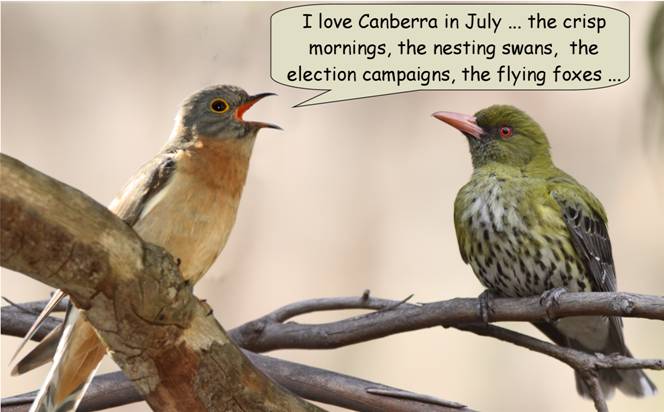To be useful, this survey needed to be ended before too many
reports began to flow in.
It was conducted over the core Winter period, the 8 weeks to
31 July. The purpose was to monitor occurrence in the Canberra area of 10
species usually regarded as present in Winter, if at all, in markedly reduced
numbers. Thanks to all who participated. 56 observers contributed
at least one observation.
Clearly, the level of observing was not entirely uniform
over the period. Some observers were active throughout the period, some
left on travels during the period, some returned during it - rather
like the birds perhaps. The results are summarised in the attached
Word document. The subject-area was the whole COG area, but there were
few observations from outside the ACT - see the note at the bottom
of the table. The greatest effort was directed to the immediate Canberra
suburban area. This included the usual woodland reserves, but these were
not visited on a daily basis, and most observations there were from visits at
weekends (note Sunday 27 June – 5 species; Sunday 18 July – 7
species; Saturday 24 July – 7 species). A reasonable
conclusion is that similar effort on each day of the period would have recorded
more numbers and species throughout the period, although perhaps not evenly
spread over the period.
COMMENTS
The first comment might state the obvious. The
occurrence, local movements and foraging pattern of each listed species is different
in Winter from during the breeding season. Species move or stay depending
on availability of food. Conditions in that regard no doubt vary from
year to year. Therefore, the Winter occurrence of all listed specie is
likely to be variable. This is confirmed by historical records.
Moreover, many of the listed species during the breeding season draw attention
by voice. Generally they are much quieter during Winter and hence are
likely to be overlooked then, when less observers are in the field
anyway.
For the individuals of the listed species present in
Winter, it is not known whether they spent the last breeding season (or
were the product of it), or will spend the next, in or near the Canberra
area. If they did not and will not, I suppose that technically they would
be ‘Winter visitors’, although in my view such labels convey little
about movements of the species as a whole.
As this particular survey had not been conducted before,
other years are not available for comparison. It is simply a record of
presence of the listed species during Winter 2010. However for purpose of
discussion that inconvenient constraint is put to one side in the following
notes.
Black-faced Cuckoo-shrike. Routinely recorded through
the period from all areas, suburban and woodland. Main concentrations
were in the Cooleman Ridge-Kathner St-Narrabundah Hill precinct. The
impression of some observers was that the same birds were involved
throughout. In some locations, Winter numbers probably exceeded numbers
present during breeding. The exercise brought to light an interesting
contribution by Martin Butterfield from GBS data. In garden sites the
BFCS had been recorded much more in early years, up until year 14. In some
early years it was recorded in EACH week of the corresponding Winter period in
15% of sites. By comparison, since 1994 garden numbers have
plummeted, a trend the current exercise tends to confirm.
Dusky Woodswallow. Here we have a comparison of
a kind, in that a similar survey for the species was conducted last year, which
produced only one record for July (CSIRO, Gungahlin), with my attention
being drawn later to a further database entry for July at Callum Brae.
Historically, July has been a very low month. By contrast the species was
widely reported this year, sometimes in numbers, throughout the period.
Jack Holland monitored a small flock at Cooleman Ridge throughout the
period. Roger Curnow found many more west of Macgregor, where he believes
40+ remained throughout the period.
Fan-tailed Cuckoo. Highly variable in
occurrence. According to ABR, records totals (not birds): 88 to 98
avge – 16; 00/01 – 105 (9 ‘overwintering’); 01/02
– 96 (11 ‘overwintering’); 06/07 – 49 (first not until
25 August). The records from Aranda woodland and ANBG were probably
overwintering birds. Perhaps the rest of this year will see a return to
relatively large numbers.
Western Gerygone. Recorded presence on 10 days
is not surprising and probably represents a small number of overwinterers (at
least 4). More likely to be recorded in Winter than the White-throated.
Noisy Friarbird and Rufous Whistler. Recorded
presence on 9 and 11 days respectively is not surprising. In few years,
if any, do these species leave the area completely. Probably Winter
wanderers, ie here today, somewhere else tomorrow.
O-b Oriole. 4 or 5 birds might have been
responsible for all reports. At least one bird was in the Ainslie/Hackett
area throughout the period, possibly true for Callum Brae also. Easily
overlooked if not calling. Contrary to this year’s records, usually
regarded as a migrant returning in September.
A Reed-Warbler. An interesting result for this
species, sometimes regarded as a typical migrant. In addition to the
records shown (2 evidenced by photos) a couple of possible sightings were not
sufficiently definite for inclusion. Reports were from widely separated
areas, Fassifern Pond, Tidbinbilla, FSW and Lake Ginn (3 reports). Some
birds were stated to be silent, some calling. Probably more birds were
present than those reported, although the total would be small by comparison
with breeding numbers.
Rufous Songlark and White-throated Gerygone, while
sometimes recorded here in Winter, were not reported in the course of this
survey.
Overall a set of records that should contribute to
understanding the movement of these species in the local area. Thanks
again to the observers who provided them. gd


